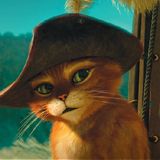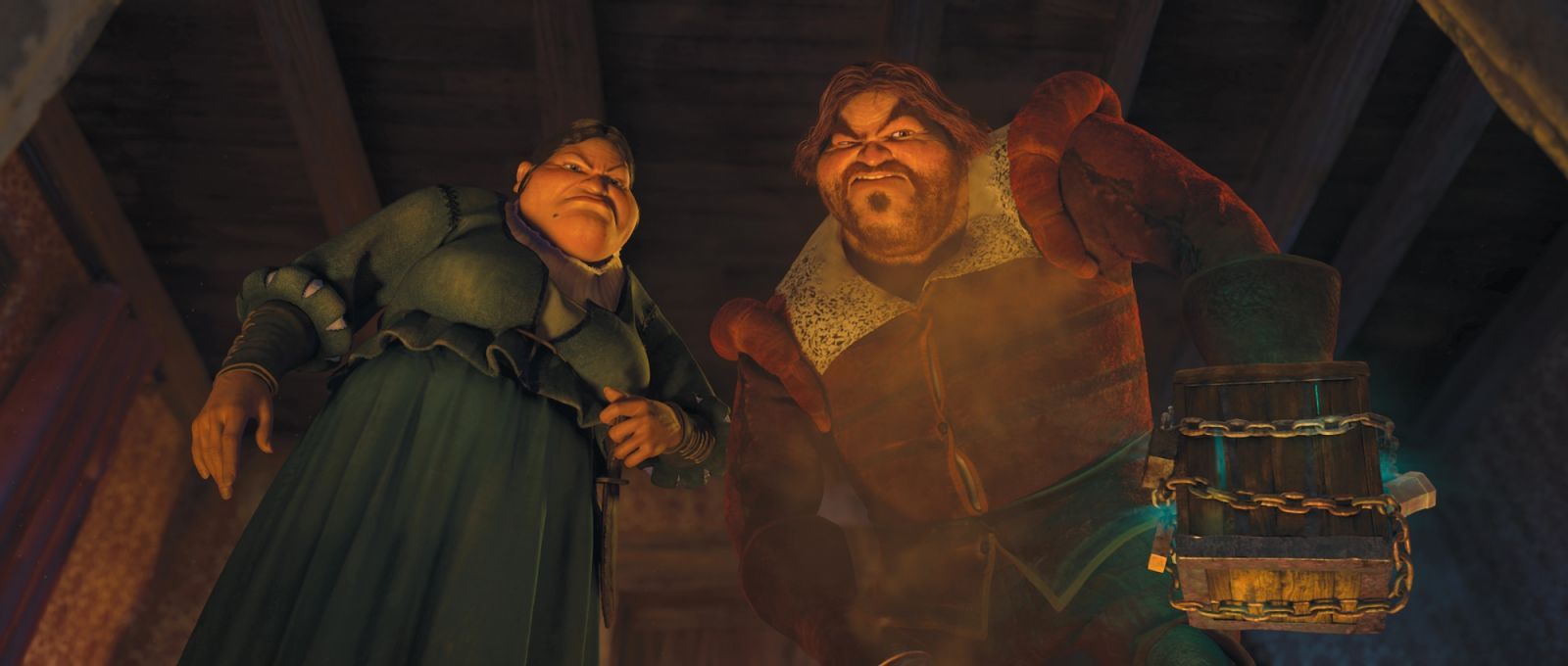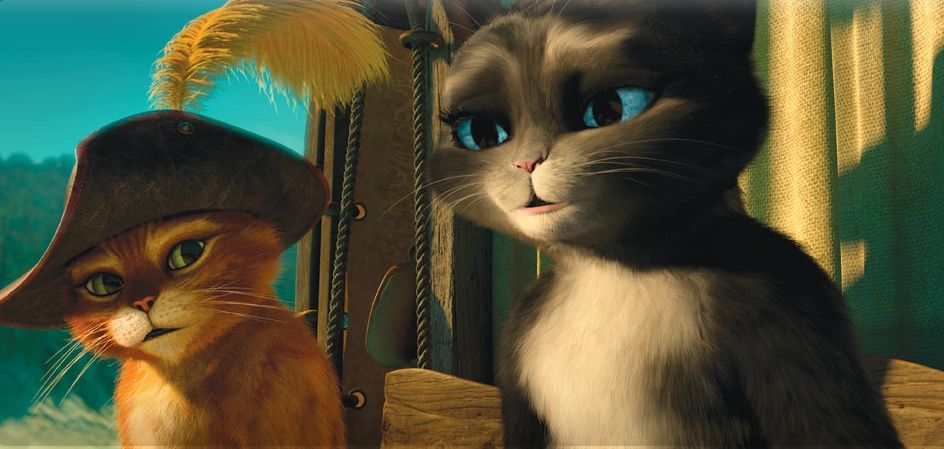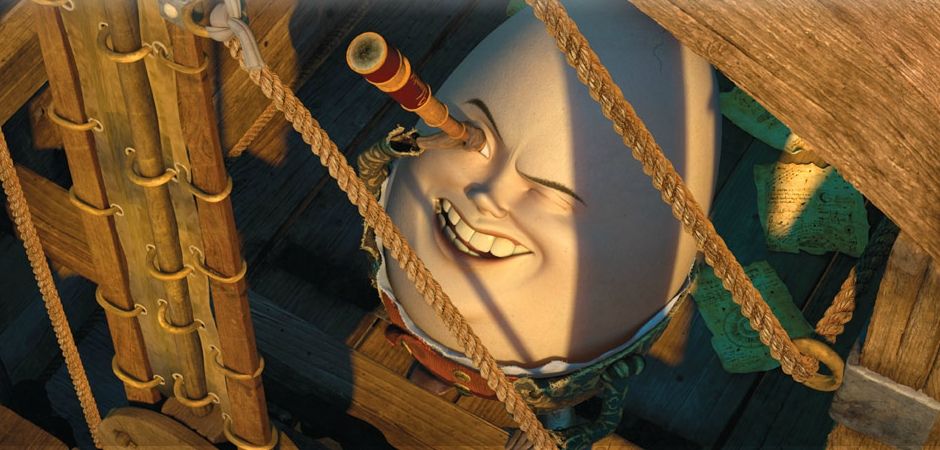Puss in Boots may be only a little cat, but his adventure and personality are larger than life. After making a splash in Shrek 2 and its sequel, the sword-wielding, boots-wearing feline, voiced with all the charisma Antonio Banderas can muster, receives his own feature with DreamWorks Animation's Puss in Boots. Equal parts Western, comedy and action-adventure, the movie combines those genres into one family-friendly package with a wit as sharp as its hero's claws.
Although its title character springs from the Shrek franchise, Puss in Boots is hardly beholden to the trappings of the blockbuster film series. Gone are Shrek, Fiona and Donkey, as well as most of the fairy-tale creatures from the land of Far, Far Away, replaced by the village of San Ricardo, the above-the-clouds land of the giants and a desert landscape fitting of a classic Western. Puss himself remains the same, albeit in a time before he ran into any ogres, and the visual style and type of adventure have been adjusted to match his personality and flair for the dramatic.
Puss' origin kicks off with the booted feline already an outlaw, wanted for a series of crimes and looking for some action -- and maybe a little leche. After an entertaining bar skirmish in which Puss flexes his Zorro muscles (a nod to Banderas' turn as the masked outlaw in The Mask of Zorro and its sequel), the bar patrons tell him Jack and Jill (Billy Bob Thornton and Amy Sedaris) are in town and possess the Beans of Legend. Those are the magic beans of "Jack and the Beanstalk" fame, which offer the promise of access to golden eggs laid by the Golden Goose.
Before Puss can get his paws on the beans, however, he encounters a mysterious cat burglar whose skills rival his own. Their bickering leads Jack and Jill to escape, and Puss pursues the burglar into an underground, all-cat nightclub. Prepared for a duel, Puss soon finds himself in a dance-off with Kitty Softpaws (Selma Hayek) in one of the film's funniest and most technically impressive sequences. The filmmakers brought in choreographer Laura Gorenstein Miller to mix several different styles of dance and give them a feline twist -- not to mention a few cat-specific moves like the "litter box." It's a hilarious scene that effortlessly showcases not only the expert level of animation, but also the film's unique tone.
When the dance-off ends, Kitty reveals to Puss she's in cahoots with Humpty Alexander Dumpty (Zach Galifianakis), a childhood friend from the orphanage where Puss grew up. Humpty and Puss didn't part amicably, and the rift between them leads to both a further exploration of Puss' kitten days as well as the driving force of the plot. The story is ultimately one of redemption for Puss and Humpty, both of whom regret what happened all those years ago in San Ricardo. Humpty's goal always was to find the magic beans, and now that fate has reunited him with Puss, it seems the time is finally right.
The story then brings them back into conflict with Jack and Jill -- including a wagon-robbery scene, again through the inventive lense of director Chris Miller, featuring a strange mechanical wagon pulled by seemingly possessed hogs -- and ultimately to the land of giants, then back to San Ricardo, where Puss and Humpty's story began. While never getting overly dark, the film plays with the notion of heroism and redemption, and the lengths characters will go to achieve the latter. The story doesn't break new ground here, but it smartly doesn't pander, or talk down, to its viewers, respecting them in a way adults will appreciate.
Tonally it's a strange beast, but not in the way you might expect: While the Shrek films are more of a send-up of the characters and genre expectations, Puss in Boots pays homage to, and finds humor in, those conceits without ever fully lampooning them. The approach enhances the action, the wonder and the danger of Puss' tale, giving the legendary feel more gravitas than it would have as a send-up of the genres it imitates.
Puss in Boots has been Banderas' character for more than seven years, and it's often hard to tell if the character is Banderas or Banderas is the character. Puss' personality is magnetic, commanding every scene and creating humor out of even the most mundane situations based on how seriously Puss (and the voice behind him) takes everything. Most of the comedy stems from the dichotomy between Puss' size and Banderas' voice, and what may have initially been a gimmick in Shrek 2 becomes a smart and well-developed character in this film. I hate to say "it's the role he was born to play" based on his strong work in front of the camera, but Banderas' silky delivery combined with the imagery is so effortlessly captivating, it's a superlative I'm not afraid to throw around.
While the movie is a vehicle for Banderas, the rest of the cast, including his frequent collaborator Salma Hayek in her first animated role, keeps up with the actor step for step. Hayek gives Kitty Softpaws cunning and toughness, making her both an effective foil and romantic interest for Puss. Billy Bob Thornton and Amy Sedaris give lively turns in their supporting roles as Jack and Jill, each providing depth and heft (on-screen and vocally), and a Southern twang, to the nefarious couple. Something clearly went wrong when Jack and Jill went up that hill, and the film shines some light on what happened to them years later. It isn't pretty, but it is entertaining.
The real treat here is Zach Galifianakis as Humpty Dumpty. It's a remarkably subtle and nuanced performance, and he gives the supporting role a much-needed complexity. Being familiar with his stand-up comedy, I was expecting Galifianakis to take me out of the movie. However, he inhabits the role so well I nearly forgot who was voicing the misguided egg. DreamWorks may not be planning a spinoff for Humpty just yet, but the studio is clearly onto something by bringing Galifianakis under its animation umbrella.
Too often studios use 3D as a gimmick to boost box-office receipts rather than as a filmmaking tool, and I tend to avoid it, especially in animation. As a Pixar junkie who saw the Toy Story 1 & 2 3D re-releases as well as the conceived-in-3D Toy Story 3, I hadn't changed my position that the technology is still largely unnecessary, especially for animation. The colors become dull, the animation isn't enhanced, and I've yet to find a 2D movie that doesn't provide the illusion of depth every 2D film since the birth of cinema has offered. That said, the 3D version of Puss in Boots is visually spectacular. All of my usual reservations, from muted colors to wasted efforts, were addressed -- and some of the sequences are downright breathtaking. I can't imagine seeing the beanstalk scene in traditional 2D. It's an exhilarating ride from the desert to above the clouds, an example of what 3D can add.
Credit where credit is due: Gil Zimmerman, who also worked on How to Train Your Dragon along with Oscar nominee Roger Deakins, is the cinematographer (or head of layout) on Puss in Boots, and he clearly knows the ins and outs of using 3D to enhance a story, not detract from it. From sweeping desert vistas to the land of the giants above the clouds, many of the shots are downright beautiful, with 3D adding a level of depth and dimension to the massive world created to house Puss' adventure. This film is also particularly impressive given the diminutive stature of the leads contrasted with the epic scope of the setting -- it really does feel bigger than the screen.
For those wondering, yes, this one plays to the cat fans. While it works as an action-comedy for those who don't care about cats one way or another, there are plenty of Easter eggs for cat lovers to enjoy. No matter that they wear boots and hats, walk and dance upright, and put themselves in perilous situations for the sake of adventure, Puss and Kitty still fall prey to their animal natures. From the distraction of moving lights to the incessant (and incredibly annoying) meowing of a cat who wants a human to do something, the film is clearly made with a love and respect for cats and their idiosyncrasies. And the adorable, big-eyed stare made famous in Shrek 2 shows up here, just as effective as it was the first time around.
Puss in Boots displays a high level of craft -- from the writing to the voice work to the animation -- and much of the credit for this has to go to Miller, a Shrek veteran who also directed Shrek the Third. He makes the film stand on its own, leaving the "safe" confines of Shrek's world and giving Puss a sweeping, epic origin worthy of the character. The challenge of directing animation is to create a singular vision utilizing a plethora of moving parts, and Miller has done exactly that with Puss.
As if often the case in cinema, and even more so in television, the magic of a supporting character often dries up when the spotlight shines solely on him. Luckily, that isn't the case with Puss in Boots, which has the potential to be the foundation for another excellent and lucrative franchise built on clever twists to the familiar and anchored by stellar voice acting.
Puss in Boots opens today nationwide.




